The Ferruginous Pygmy Owl (Glaucidium brasilianum) stands as a captivating avian species, encompassing a diverse range across the Americas.
Characterized by its diminutive stature and striking reddish-brown plumage, this owl commands attention within the expansive tapestry of birdlife.
With a notable diurnal hunting behavior, it defies nocturnal norms associated with its larger owl counterparts.
Spanning from the southern United States to northeast Argentina, the Ferruginous Pygmy Owl’s extensive geographic distribution unveils a fascinating array of subspecies, each finely tuned to specific habitats.
From arid landscapes to tropical rainforests, these owls exhibit remarkable adaptability, emphasizing their ecological resilience.
Their haunting calls punctuate the daylight hours, underscoring their role as both predators and contributors to the intricate ecosystems they inhabit.
As a species emblematic of avian versatility, the Ferruginous Pygmy Owl invites exploration into the nuanced interplay between environment and evolution within the avian realm.
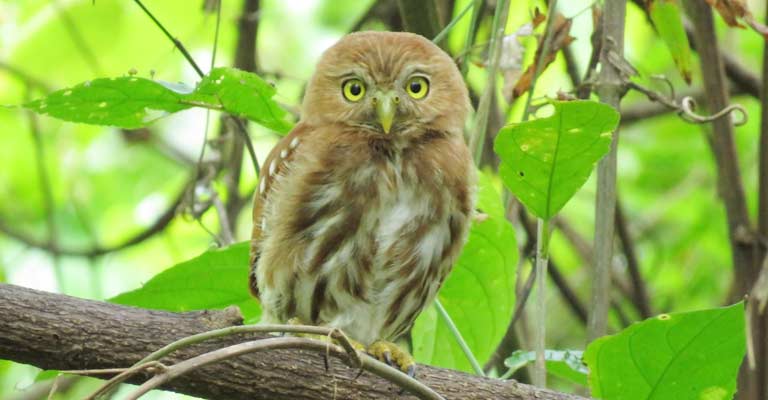
Identifying Characteristics of Ferruginous Pygmy Owl
The Ferruginous Pygmy Owl (Glaucidium brasilianum) possesses a distinctive set of characteristics that render it identifiable amidst the avian landscape. Here are eight key points to aid in the identification of this captivating species:
Size and Stature
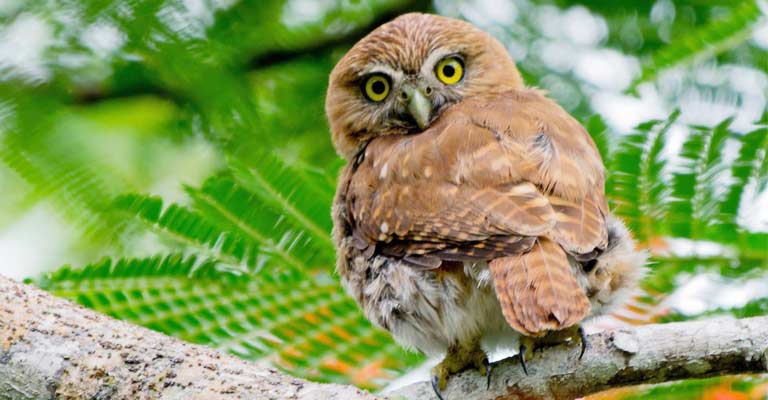
The Ferruginous Pygmy Owl is notably petite, measuring around 6 to 7 inches in length. Its compact stature, coupled with a round facial disk, sets it apart from larger owl species.
Despite its small size, the owl exhibits a robust and captivating presence.
Plumage and Coloration
A defining feature of the Ferruginous Pygmy Owl is its reddish-brown plumage, which serves as effective camouflage in various habitats. This coloration extends across its body, creating a uniform appearance.
The owl’s underparts may exhibit a lighter tone, contributing to its overall striking and well-defined appearance.
Facial Disk and Eyes
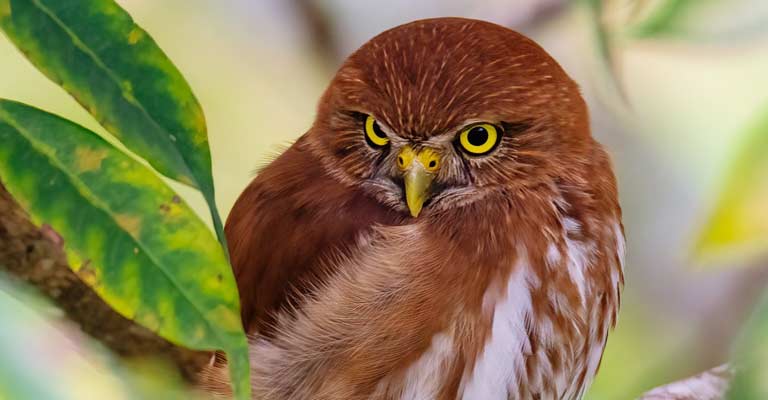
The owl’s facial disk, a characteristic feature of many owl species, is rounded and framed by a distinct border. Its eyes, a striking yellow color, are large and forward-facing, enhancing its ability to focus on prey during daylight hunting.
Tail and Flight Pattern
Observing the Ferruginous Pygmy Owl in flight reveals its short tail, which contrasts with the longer tails of some other owl species.
The flight pattern is generally undulating and swift, with the owl often gliding between perches in a series of graceful movements.
Habitat and Range
Understanding the bird’s habitat is crucial for identification. Ferruginous Pygmy Owls inhabit a diverse range of ecosystems, from open woodlands and forests to urban areas.
Knowing the specific range of the subspecies in question further aids in accurate identification.
Distinctive Call
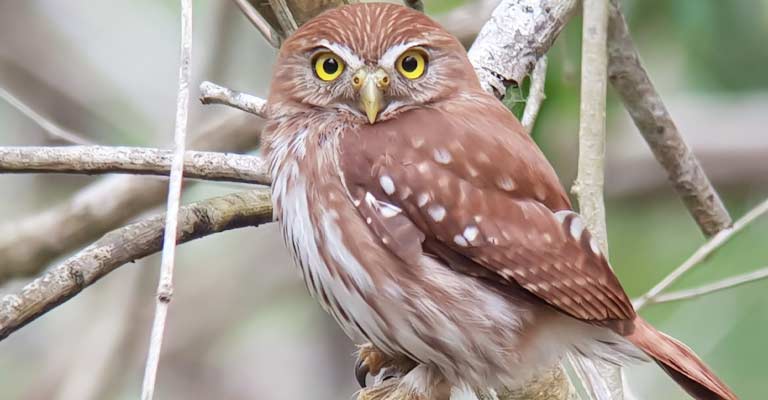
The Ferruginous Pygmy Owl is known for its unique and haunting call, often described as a series of whistles or rhythmic toots.
Familiarizing oneself with this distinctive vocalization enhances the likelihood of identifying the species even when it remains hidden within the foliage.
Diurnal Behavior
Unlike many primarily nocturnal owl species, the Ferruginous Pygmy Owl exhibits diurnal hunting behavior. Active during daylight hours, it capitalizes on its keen vision and hearing to locate and capture prey.
Geographical Variation
Recognition of the Ferruginous Pygmy Owl’s various subspecies and their specific geographical distributions adds layer to the identification.
Subtle variations in coloration and markings may exist among subspecies, necessitating a nuanced understanding of regional characteristics.
By combining these key points, bird enthusiasts and observers can develop a comprehensive understanding of the Ferruginous Pygmy Owl’s identifying features, fostering a deeper appreciation for this remarkable and adaptable avian species.
Taxonomy of Ferruginous Pygmy Owl
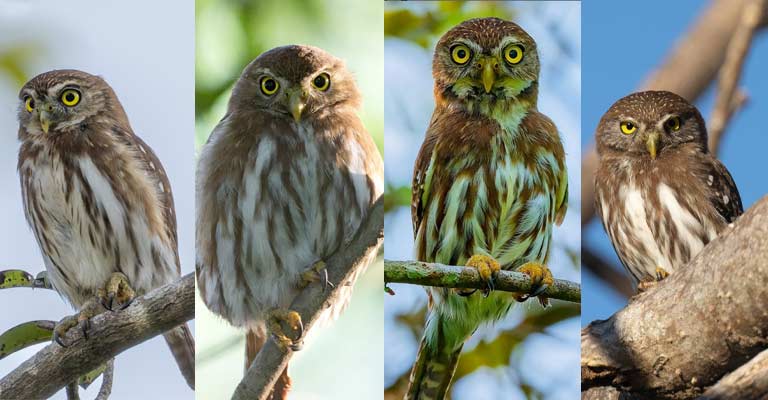
Here’s a table that will show you all the taxonomy details of the Ferruginous Pygmy Owl:
| Taxonomic Rank | Classification |
| Domain | Eukaryota |
| Kingdom | Animalia |
| Phylum | Chordata |
| Class | Aves |
| Order | Strigiformes |
| Family | Strigidae |
| Genus | Glaucidium |
| Species | G. brasilianum |
The Ferruginous Pygmy Owl (Glaucidium brasilianum) is a small owl species belonging to the family Strigidae. With a distinctive reddish-brown plumage, it is found in various habitats across the Americas, from the southern United States to Argentina.
Typically measuring around 6 to 7 inches in length, this owl has a round facial disk, yellow eyes, and a relatively short tail. Its taxonomy includes the kingdom Animalia, phylum Chordata, class Aves, order Strigiformes, and family Strigidae.
The Ferruginous Pygmy Owl is known for its diurnal hunting behavior and preference for open woodlands, forests, and urban areas.
Subspecies of Ferruginous Pygmy Owl
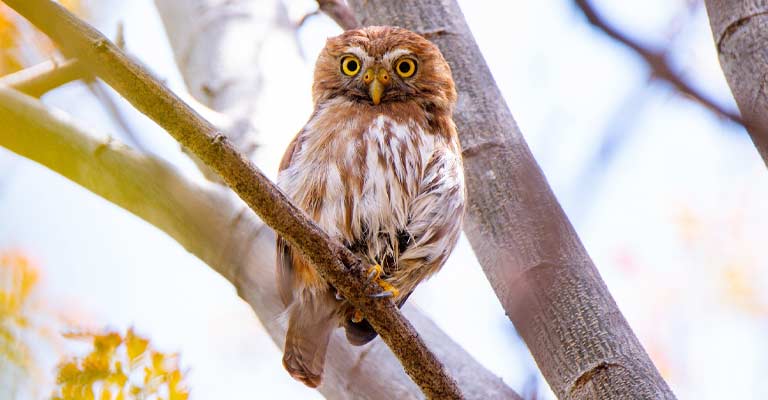
The Ferruginous Pygmy Owl (Glaucidium brasilianum) exhibits distinct regional variations across its range, showcasing a fascinating diversity within the species.
Here are five subspecies:
G. b. cactorum (Van Rossem, 1937)
Found from southern Arizona, USA, to Sonora and north Nayarit in western Mexico, this subspecies thrives in diverse habitats.
Its adaptation to arid regions, including cacti-rich landscapes, highlights its remarkable ability to thrive in varied environments.
G. b. intermedium (Phillips, AR, 1966)
Inhabiting regions from south Nayarit to Oaxaca in western Mexico, this subspecies displays unique characteristics.
Its presence in the transitional zones between habitats underscores its adaptability to diverse ecosystems, contributing to the overall ecological resilience of the Ferruginous Pygmy Owl.
G. b. ridgwayi (Sharpe, 1875)
Ranging from south Texas in the central south USA to west Panama, this subspecies is notable for its extensive geographical distribution.
The adaptability of G. b. ridgwayi to both temperate and tropical climates reflects its versatility and ability to thrive in different ecological niches.
G. b. medianum (Todd, 1916)
Inhabiting northern Colombia, this subspecies showcases distinctive features within the Ferruginous Pygmy Owl population.
Its presence in the lush ecosystems of Colombia underscores its specialization and adaptation to the specific environmental conditions of the region.
G. b. margaritae (Phelps, WH & Phelps, WH Jr, 1951)
Confined to Margarita Island off Venezuela, this insular subspecies exhibits unique characteristics shaped by island ecology.
Its isolation emphasizes the role of geographical factors in influencing the evolutionary trajectory of the Ferruginous Pygmy Owl.
G. b. phaloenoides (Daudin, 1800)
Inhabiting the northern and eastern regions of Venezuela, Trinidad, and the Guianas, this subspecies displays adaptations to the diverse ecosystems of this territory.
Its presence underscores the ability of the Ferruginous Pygmy Owl to inhabit and thrive in varied landscapes.
G. b. duidae (Chapman, 1929)
Confined to Cerro Duida in southern Venezuela, this subspecies exemplifies the specialization that can occur in isolated regions.
Its adaptation to the specific conditions of Cerro Duida showcases the Ferruginous Pygmy Owl’s ability to evolve unique traits in response to distinct ecological factors.
G. b. olivaceum (Chapman, 1939)
Thriving in the challenging environment of Auyán Tepui in southeastern Venezuela, this subspecies showcases the adaptability of the Ferruginous Pygmy Owl to elevated and rugged terrains.
The unique features of G. b. olivaceum reflect its specialization in this distinctive geographic setting.
G. b. ucayalae (Chapman, 1929)
Inhabiting the Amazonian region, this subspecies demonstrates the Ferruginous Pygmy Owl’s ability to navigate the complexities of the Amazon rainforest.
- b. ucayalae’s characteristics highlight the species’ resilience in one of the world’s most biodiverse and challenging ecosystems.
G. b. brasilianum (Gmelin, JF, 1788)
Inhabiting the expansive region from eastern Brazil to northeast Argentina, this subspecies showcases the Ferruginous Pygmy Owl’s adaptability to the diverse ecosystems of the eastern part of its range.
The characteristics of G. b. brasilianum reflect the species’ ability to thrive in the varied landscapes of this extensive territory.
G. b. pallens (Brodkorb, 1938)
Occupying eastern Bolivia, west Paraguay, and northern Argentina, this subspecies exemplifies the Ferruginous Pygmy Owl’s presence in the transitional zones between different countries.
Its features likely reflect adaptations to the unique environmental conditions of this border region.
G. b. stranecki (König, C & Wink, 1995)
Distributed from central Argentina to southern Uruguay, this subspecies represents the Ferruginous Pygmy Owl’s adaptation to the temperate climates of the Southern Cone.
- b. stranecki’s characteristics highlight the species’ ability to thrive in the distinct ecological settings of this geographic area.
G. b. tucumanum (Chapman, 1922)
Found in western Argentina, this subspecies is likely adapted to the specific conditions of the region.
Its presence in the western part of Argentina suggests potential variations in behavior and morphology shaped by the environmental factors prevalent in this area.
These subspecies collectively contribute to the rich tapestry of biodiversity within the Ferruginous Pygmy Owl, showcasing the species’ ability to adapt and thrive in diverse habitats across the Americas.
Ferruginous Pygmy Owl Life History
The life history of the Ferruginous Pygmy Owl (Glaucidium brasilianum) unfolds as a testament to the species’ adaptability and resilience across diverse landscapes in the Americas.
From its feeding habits to breeding behaviors, each facet contributes to the intricate tapestry of this captivating owl’s existence.
Food
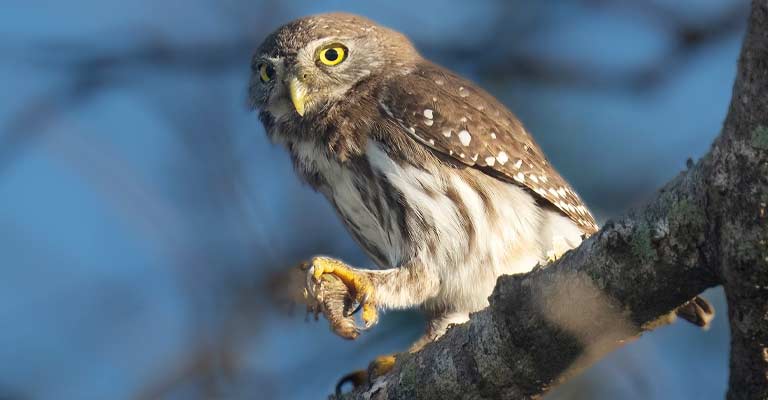
Ferruginous Pygmy Owls are opportunistic predators with a varied diet that includes small mammals, birds, insects, and reptiles.
Their diurnal hunting behavior sets them apart from many nocturnal owls, allowing them to capitalize on the activity of their prey during daylight hours.
Habitat
These owls exhibit remarkable versatility in habitat selection, thriving in a range of environments.
From open woodlands and forests to urban areas, they demonstrate adaptability to diverse landscapes throughout their extensive range in the Americas.
Range Map
The Ferruginous Pygmy Owl’s range spans from the southern United States to northeast Argentina.
A detailed range map highlights the specific territories of different subspecies, emphasizing the species’ ability to occupy habitats from arid regions to tropical rainforests.
Nesting
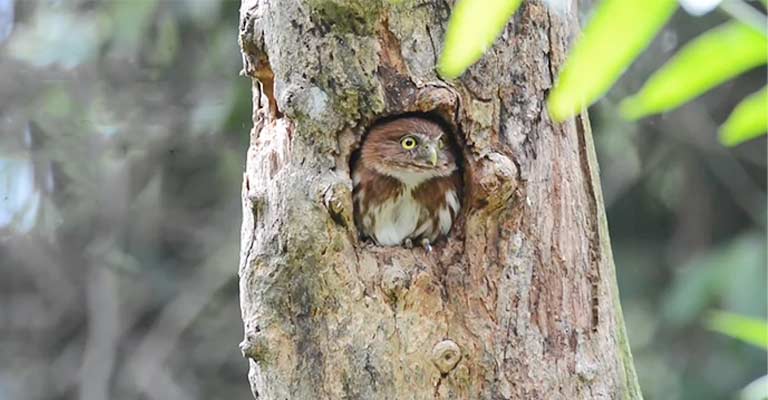
Nesting habits involve the selection of tree cavities or abandoned nests, where females lay a clutch of eggs. The choice of nesting sites varies, and the female diligently incubates the eggs while the male provides food.
Here’s a table summarizing nesting details for the Ferruginous Pygmy Owl:
| Nesting Details | Facts |
| Clutch Size | 2 to 4 eggs |
| Number of Broods | Usually 1 per breeding season |
| Egg Length | Approximately 26-30 mm |
| Egg Width | Approximately 21-25 mm |
| Incubation Period | Around 28 days |
| Nestling Period | Approximately 25 to 30 days |
| Egg Description | White with a smooth texture |
| Nest Type | Often uses tree cavities or abandoned nests |
| Nest Location | Varied, including deciduous trees and cacti |
Breeding
Breeding activities often coincide with the availability of food resources. Mating pairs engage in courtship rituals, and once eggs are laid, the parents collaborate in caring for the chicks.
The fledglings remain dependent on parental care until they are ready to venture out on their own.
Diseases
Ferruginous Pygmy Owls may face threats from various diseases, including avian diseases and environmental factors.
Monitoring their health is crucial, particularly in regions where they may encounter human-induced risks such as habitat fragmentation and pesticides.
Treatment
Conservation efforts often involve monitoring and addressing potential health concerns.
If diseases are identified, intervention strategies may include habitat restoration, education on pesticide use, and measures to mitigate anthropogenic impacts.
Conservation
The Ferruginous Pygmy Owl faces challenges such as habitat loss and fragmentation. Conservation initiatives focus on preserving diverse habitats, raising awareness, and implementing measures to mitigate human-induced threats.
Local and international collaboration is essential for the effective conservation of this species.
The life history of the Ferruginous Pygmy Owl is a fascinating narrative of adaptability, showcasing its ability to navigate diverse ecosystems across the Americas.
Conservation efforts play a pivotal role in safeguarding the future of this species, ensuring that its story continues to unfold amid the intricate landscapes it calls home.
Behavioral Habits of Ferruginous Pygmy Owl
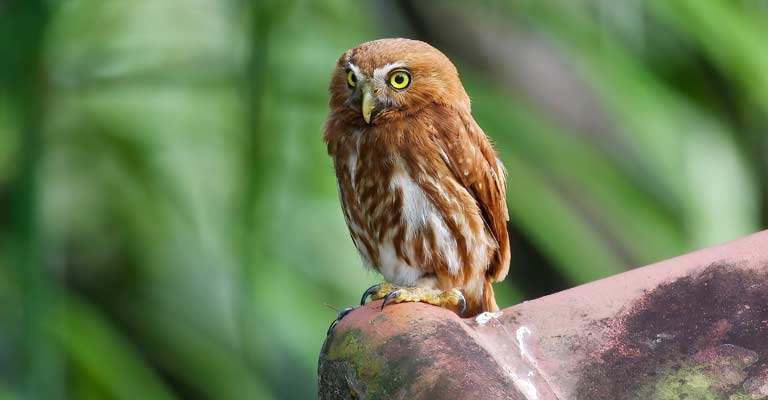
The Ferruginous Pygmy Owl (Glaucidium brasilianum) not only captivates with its striking appearance but also exhibits a range of fascinating behavioral habits.
From hunting strategies to communication methods, these behaviors shed light on the adaptive nature of this diminutive owl species.
Hunting Behavior
Unlike many nocturnal owls, the Ferruginous Pygmy Owl is diurnal, actively hunting during daylight hours.
This behavioral adaptation allows it to exploit the increased activity of its prey, which includes small mammals, birds, insects, and reptiles.
With swift and undulating flight patterns, these owls demonstrate agility in capturing prey, often relying on keen vision and precise auditory capabilities.
Communication and Vocalizations
Communication among Ferruginous Pygmy Owls involves a repertoire of vocalizations. Their distinctive call is often described as a series of rhythmic toots or whistles.
These vocalizations serve multiple purposes, from marking territory and establishing presence to signaling during courtship and breeding seasons. The owl’s vocal expressions provide valuable insights into its social dynamics and environmental interactions.
Territoriality and Defense
Ferruginous Pygmy Owls are known for their territorial behavior, fiercely defending their nesting sites and hunting territories.
This territoriality is often accompanied by aggressive displays, including hooting, bill-clapping, and, in some cases, physical confrontations with intruders.
This defensive behavior is crucial for protecting resources and ensuring reproductive success.
Roosting and Resting
During non-hunting hours, Ferruginous Pygmy Owls require suitable roosting sites for rest and concealment. These roosts are typically selected based on factors such as proximity to hunting grounds and shelter from potential predators.
The choice of roosting sites reflects the owl’s ability to adapt to its surroundings for both safety and strategic hunting.
Parental Care and Breeding
The breeding season prompts intricate behaviors related to courtship and parental care. Mating pairs engage in courtship rituals, often accompanied by vocalizations.
Both male and female Ferruginous Pygmy Owls actively participate in incubating the eggs and caring for the nestlings. This collaborative parental involvement is crucial for the survival of their offspring.
In essence, the behavioral habits of the Ferruginous Pygmy Owl highlight its adaptive strategies for survival and reproduction.
From diurnal hunting to intricate vocalizations and territorial defense, these behaviors weave a complex narrative of a species finely attuned to the demands of its environment.
Studying these habits not only enhances our understanding of the owl’s ecological role but also deepens our appreciation for the intricacies of avian behavior.
Wrapping Up
The Ferruginous Pygmy Owl (Glaucidium brasilianum) emerges as a captivating and resilient species, weaving its narrative across the diverse landscapes of the Americas.
From its distinctive reddish-brown plumage to diurnal hunting behaviors, this diminutive owl showcases an array of adaptations that underscore its ability to thrive in various environments.
The exploration of its life history, nesting details, and behavioral habits unravels a story of versatility and resilience, emphasizing its vital role in maintaining ecological balance.
As conservation efforts gain prominence, understanding the nuances of the Ferruginous Pygmy Owl’s existence becomes imperative.
The complexities of its habitat requirements, breeding strategies, and territorial behaviors underscore the importance of holistic conservation approaches.
Appreciating the interconnectedness of these elements not only deepens our admiration for this remarkable owl but also underscores the broader significance of preserving biodiversity.
In the face of environmental challenges, the Ferruginous Pygmy Owl stands as a symbol of adaptability, urging us to foster a collective commitment to safeguarding the intricate tapestry of life within our shared ecosystems.